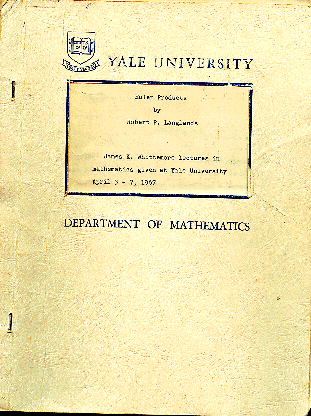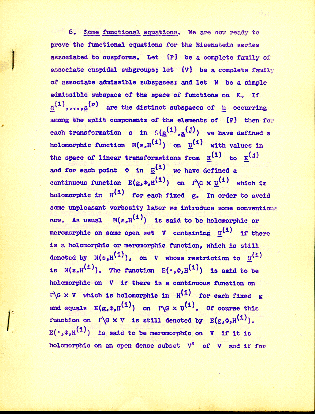Eisenstein series and automorphic forms

Editorial comments: The letter to Weil included a number of striking conjectures which eventually changed much of the direction of research in automorphic forms. Some of their consequences were explained in a graduate course given at Princeton in the spring of 1967, and then things were put in a somewhat wider context in a series of lectures at Yale later that Spring. These notes were previously published as the first of the Yale Mathematical Monographs.
Author's comments: This monograph was based on lectures given early in April of 1967 at Yale University, thus several months after the letter to Weil. None the less it is reticent about the conjectures formulated in that letter. Results are formulated in terms of the dual group introduced there, which could for the groups of the lectures be introduced without any reference to the Galois group because only split groups are treated. There is, however, only the slightest of allusions to any generalization of class-field theory: the observations that what can be done for one reductive group should be done for all and that the identification of an automorphic \(L\)-function with an Artin \(L\)-function or with a Hasse-Weil \(L\)-function is tantamount to a reciprocity law. These two observations underline that functoriality arose in an attempt to find a nonabelian class-field theory under the influence of the view, which arose in the early sixties, that much of the theory of automorphic forms could and should be treated in the context of group representations. The major technical impulse was the need for a concisely defined general class of Euler products that included those arising from the theory of Eisenstein series.
The formula (6), which is established in sufficient generality to verify the convergence of the Euler products, is not established in general, although it is surmised that it is generally true. This was, indeed, proved a little later in complete generality and, so far as I know, quite independently by Ian MacDonald (Spherical functions on a group of \(p\)-adic type). I had heard of his result, even though his monograph was not yet available, by the time Problems in the theory of automorphic forms was written, so that I could simply invoke it. The formula now carries, quite rightly, his name.
The formula referred to as the formula of Gindikin-Karpelevich was, indeed, proved in general by them, but had first been discovered by Bhanu-Murty and proved by him for the special linear group over \(\mathbf R\) in мера Планшереля для фактор-пространства \(\mathrm{SL}(n,\mathbf R)/\mathrm{SO}(n,\mathbf R)\), ДАН 133 (1960).
Although the notes for the lectures were available as a preprint at the time they were delivered or shortly thereafter, the monograph did not appear until 1970. Apart from the addition of one or two footnotes and the correction of misprints and slips of the pen, there were no alterations.
Gelbart and Shahidi have written a useful survey of the theory of automorphic \(L\)-functions, Analytic properties of automorphic \(L\)-functions. I recommend it to the reader of Euler products.
Editorial comments:
- This was written in 1964 and distributed for many years in a famous purple mimeographed document by the Yale University Mathematics Department. It was later published in the Springer Lecture Notes series (volume 544).
- 2015-12-02, AVP: We would like to note that we have done our best to clarify several arguments, sometimes without having fully reconstructed them. Many thanks also to Allan Adler for a long list of corrections.
- 2016-07-22, AVP: We compared several charts and text from appendix III to the author's original handwritten notes and adjusted this online text to match them.
Editorial comments: This originally appeared as a supplement to an article by A. Borel and H. Jacquet in Automorphic forms, representations, and L-functions, Proceedings of Symposia in Pure Mathematics XXXIII, AMS, 1979.
Letters
Letter to Ono
Author's comments: This letter was written from Berkeley.
Letter to Godement
Editorial comments: The letter to Weil that saw the birth of the \(L\)-group was written in January 1967. Somewhat later that same year, Roger Godement asked Langlands to comment on the Ph.D. thesis of Hervé Jacquet. His reply included a number of conjectures on Whittaker functions for both real and \(p\)-adic reductive groups. These were later to be proven, first in the \(p\)-adic case by Shintani for \(\mathrm{GL}_n\) and Casselman Shalika in general, and much later in the real case by a longer succession of people.
Author's comments: This letter, a report on Jacquet's thesis, is undated, but a letter from Godement dated May 12th, 1967 asks that the report be submitted before the end of May. I assume it was sent from Princeton so as to arrive in Paris before the date requested.
The notation may cause the reader some difficulties. Some symbols, for example \(\chi\), have meanings that change (sometimes explicitly but sometimes only implicitly) in the course of the letter. There is a particularly dangerous lapse in regard to \(\xi\). Other symbols, sometimes the same, are employed in ways that have become uncommon. The symbol \(\pi\) appears, for example, as a representation of a compact group. The notation \(\langle a, \alpha\rangle\) for the value of the multiplicative function \(\alpha\) at the group element \(a\) is particularly disconcerting.
References to pages either in Jacquet's thesis or in the handwritten letter have been allowed to stand.
The formula for Whittaker functions for unramified representations suggested in the letter was proved by Casselman and Shalika.
It appears from the Institute records that Godement visited Princeton early in March of 1967. It must have been then that I spoke to him. The lectures at Yale were given early in April of 1967 and appeared later as the monograph Euler products (included just above).
